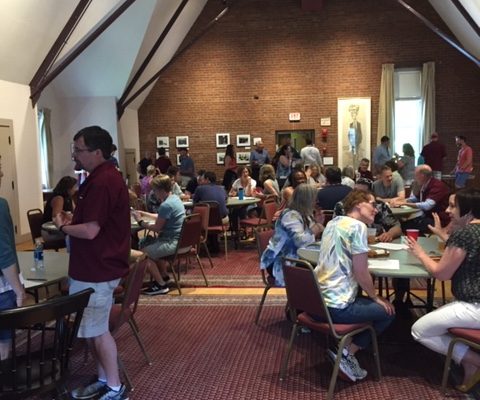A few weeks ago, I attended my college reunion at Bates College. I co-hosted a conversation among around 60 alumni about leadership, with my friend J.J. Cummings. Instead of a typical panel presentation, we invited everyone to consider this question:
Share a story from your experience of what you have learned about what it takes to be a successful leader (i.e., from your own experience or the leadership qualities you admire in others). What are common themes?
 People were given several minutes to reflect on their own and then invited to share their story in pairs, followed by conversations in groups of four. (This 1-2-4-All process works well to get many meaningful conversations going throughout a room.) When themes were shared in the larger group, one mentioned several times was the importance of learning how to navigate failure.
People were given several minutes to reflect on their own and then invited to share their story in pairs, followed by conversations in groups of four. (This 1-2-4-All process works well to get many meaningful conversations going throughout a room.) When themes were shared in the larger group, one mentioned several times was the importance of learning how to navigate failure.
Next, we asked them to discuss: How can Bates best prepare its students to be strong workforce leaders tomorrow? Here again, several people emphasized the importance of having experiences of trying and failing, and learning from them, e.g. that students should “take ownership of their failures and think of ways to resolve them.” Others talked about this as “building grit.”
An Experience in Navigating Failure
Several people mentioned one particular class that had the biggest impact on them. It was a Psychology class I took my senior year and I agreed it was my most frustrating, yet memorable class. The class was called Group Dynamics and had about 15 people. As I recall, it met once a week for three hours on a weeknight. Our first class, Professor Dick Wagner announced that it was up to us to organize how we wanted to run the class and learn about group dynamics. We had a text book. Then he stepped back and let us work it out.
One of my fellow students, Michelle Bennett, described it this way: “It was such a foreign concept, no format, no rules, no structure, just a group of students. We had always had education and learning presented to us and with clear guidelines, a syllabus and expectations. This was uncharted territory. We literally had to create something from nothing. It was clear that we had never experienced anything like this before. I guess it is not a comfortable place to be and yet we were close to launching into the real world and the job market. Boy, did it feel uneasy and unsettling!”
Week after week, we had frustrating conversations, unable to work out a plan for how to cover the material. The group struggled to come to consensus on anything. We had no training in group process, facilitation, or in how to prioritize multiple options. No one seemed to want to compromise or let a few people decide.
We were learning first-hand how group dynamics work – or don’t work. The level of emotion and frustration ran high and was uncomfortable. The professor was fascinated to watch the process unfold. He said that he had never seen a class struggle as much as ours. Even so, he did not step in to teach or direct. Eventually, I think we landed on a plan of sub-teams teaching themes. The process of group dynamics not working was as much the learning as what was in the book.
Now at reunion 30 years later, people could recall so vividly what they experienced and learned in that class. I shared that I had gone on to become a facilitator, so perhaps the frustration of that class set the course of my career!
Discovering the Resources
The first year after college I worked in a consulting firm where I was trained in Total Quality Management, which included processes to help groups make decisions. We learned the multi-voting method, where each person gets 3 votes to pick the idea(s) they most like. It allows a group to quickly prioritize a list of ideas. I thought “Oh my God – if we had just had this method in Group Dynamics, it could have saved us hours of frustration!” It’s nice to recognize that now, years later, I have a tried-and-true tool box of resources for helping groups self-organize with no structure, e.g., strategic questions, the Art of Hosting, Liberating Structures, and our meeting design approach.
As I think about students today, the focus on standardized tests and competition to get into colleges and grad schools can drive a focus on perfection and avoiding mistakes at all costs. Reflecting on the experience in the class showed me the power of experiential learning and being put in positions where we had to struggle and experience frustration. What I also see, particularly as we think of the challenges ahead with a changing climate, is a need to train students in how to collaborate and self-organize when there isn’t a clear structure or road map of what to do.
Here are the other themes that alumni suggested the college offer to best prepare its students to be strong leaders:
- Establish a culture where conversation is fostered and encourage more open dialogue, communication and ability to listen, and tolerance
- Understanding group dynamics and give opportunities to take responsibility
- Negotiation
- Think about the value of foundational humanities (especially within the context of emphasis on STEM)
- Being well-rounded
- Understanding and using the word “no”
- Principles of service, e.g, have students involved in the community
- Create opportunities for students to take on projects
